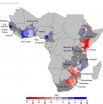(Press-News.org) Lacrosse is one of the fastest-growing high school sports in the United States, with more than 170,000 students now playing the sometimes hard-hitting game. The growing participation numbers, however, mean that more young people than ever are at risk of injury in lacrosse practice and competition.
In a study published online today by The American Journal of Sports Medicine and available in an upcoming print issue, researchers from the Center for Injury Research and Policy at Nationwide Children's Hospital and the Colorado School of Public Health found that high school players experienced 1,406 injuries over the 4 academic years from 2008 through 2012. The overall injury rate was 20 per 10,000 lacrosse competitions and practices.
More than 22 percent of those injuries were concussions, making that the second most common injury diagnosis behind sprains and strains (38 percent).
Researchers also found that while the rules for girls' lacrosse largely prohibit person-to-person contact, almost 25 percent of concussions in girls' lacrosse were a result of that kind of contact. Another 63 percent of concussions resulted from being struck by lacrosse sticks or balls. Most high school girls' lacrosse players are only required to use protective eyewear and mouth guards, and not the helmets and additional padding required for boys' lacrosse.
"Lacrosse is becoming more and more popular across the United States, and it's a great way for high school students to be active," said Lara B. McKenzie, PhD, an author of the study, principal investigator in the Center for Injury Research and Policy at Nationwide Children's and associate professor at the Ohio State University College of Medicine. "Still, we see injuries in the sport every day during the season. Our research shows that we need to do more and can do more to prevent those injuries."
Boys' and girls' high school lacrosse have different rules regarding person-to-person contact, and the study found that the number and kinds of injuries differed between the genders. Boys sustained 67 percent of the total injuries, and boys had a higher overall injury rate than girls. About 36 percent of boys' injuries were sprains and strains, and about 22 percent were concussions. Person-to-person contact, which is allowed in boys' lacrosse, caused 74 percent of concussions and 41 percent of boys' lacrosse injuries overall.
Almost 44 percent of injuries to girls were sprains and strains, and concussions made up another 23 percent. The most common causes of injuries were no contact – for example, a foot pivot leading to a pulled muscle -- and contact with playing equipment. For both boys and girls, injury rates were higher during competition than practice.
Dawn Comstock, PhD, an author of the study and an professor of Epidemiology for the Pediatric Injury Prevention, Education, and Research (PIPER) program at the Colorado School of Public Health, said that the study's findings will contribute to evidence-based discussions of ways to prevent injury – including the current debate over whether girls' lacrosse players should wear helmets as boys are required to do.
"Concern over concussions in both boys' and girls' lacrosse underscores the need to learn more about these injuries," Comstock said. "Further study will help those working to develop and implement effective injury prevention programs."
Players, coaches, officials, athletic trainers and parents can help make lacrosse a safer game by following these tips from researchers and lacrosse organizations:
Strictly enforce all rules, especially those limiting player-to-player contact in both boys' and girls' lacrosse.
Learn the symptoms of concussion. Any athlete suspected of having a concussion should stop play immediately and be evaluated by a certified athletic trainer or other medical professional.
Warm up properly, drink plenty of water, and rest after practice or competition.
Wear well-fitting protective equipment.
Be prepared for injuries before they happen by making sure procedures, such as emergency action plans, are in place to handle them.
The study is the first to use a large national sample of United States high schools to compare lacrosse injuries by type of athletic activity and gender. Data was collected from the National High School Sports-Related Injury Surveillance System, High School RIO (Reporting Information Online), which uses reports from certified athletic trainers throughout the country.
INFORMATION:
The Center for Injury Research and Policy (CIRP) of The Research Institute at Nationwide Children's Hospital works globally to reduce injury-related pediatric death and disabilities. With innovative research at its core, CIRP works to continually improve the scientific understanding of the epidemiology, biomechanics, prevention, acute treatment and rehabilitation of injuries. CIRP serves as a pioneer by translating cutting edge injury research into education, policy, and advances in clinical care. For related injury prevention materials or to learn more about CIRP, visit http://www.injurycenter.org.
The Colorado School of Public Health is the first and only accredited school of public health in the Rocky Mountain Region, attracting top tier faculty and students from across the country, and providing a vital contribution towards ensuring our region's health and well-being. Collaboratively formed in 2008 by the University of Colorado, Colorado State University, and the University of Northern Colorado, the Colorado School of Public Health provides training, innovative research and community service to actively address public health issues including chronic disease, access to healthcare, environmental threats, emerging infectious diseases, and costly injuries.
New study finds high school lacrosse players at risk for concussions, other injuries
Researchers say statistics may further debate over protective equipment for girls
2014-07-22
ELSE PRESS RELEASES FROM THIS DATE:
Schizophrenia's genetic 'skyline' rising
2014-07-22
The largest genomic dragnet of any psychiatric disorder to date has unmasked 108 chromosomal sites harboring inherited variations in the genetic code linked to schizophrenia, 83 of which had not been previously reported. By contrast, the "skyline" of such suspect variants associated with the disorder contained only 5 significant peaks in 2011. By combining data from all available schizophrenia genetic samples, researchers supported by the National Institutes of Health powered the search for clues to the molecular basis of the disorder to a new level.
"While the suspect ...
Largest gene discovery 'kick-starts' new search for schizophrenia treatments
2014-07-22
VIDEO:
Largest gene discovery helps 'kick-start' new search for schizophrenia treatments - The discovery of over a hundred genetic risk factors linked to schizophrenia provides vital new clues in understanding what...
Click here for more information.
The discovery of over a hundred genetic risk factors linked to schizophrenia provides vital new clues in understanding what causes the condition and will kick-start the search for new treatments, according to leading UK scientists. ...
International team sheds new light on biology underlying schizophrenia
2014-07-22
July 21, 2014 (Toronto) – As part of a multinational, collaborative effort, researchers from Canada's Centre for Addiction and Mental Health (CAMH) have helped identify over 100 locations in the human genome associated with the risk of developing schizophrenia, in what is the largest genomic study published on any psychiatric disorder to date. The findings, published online in Nature, point to biological mechanisms and pathways that may underlie schizophrenia, and could lead to new approaches to treating the disorder, which has seen little innovation in drug development ...
LSU's Mark Batzer contributes to Nature Genetics article on marmoset genome
2014-07-21
BATON ROUGE – LSU's Mark Batzer, Boyd Professor and Dr. Mary Lou Applewhite Distinguished Professor in Department of Biological Sciences in the College of Science, contributed to an article in the scientific journal Nature Genetics, titled "The Common Marmoset Genome Provides Insight into Primate Biology and Evolution," published on July 20.
Batzer contributed analysis of "jumping genes," or mobile elements that move by a sort of "copy and paste" mechanism in the genome. The marmoset is important because it is the first "New World" monkey genome to be sequenced.
An ...
Temple study compares deep vein thrombosis therapies
2014-07-21
(Philadelphia, PA) – Patients who have a clot in their legs and are considering whether to be treated with traditional blood-thinning medication or undergo a minimally-invasive catheter-based clot removal procedure should feel comfortable that there is no difference in death rates between the two treatments, although there are more bleeding risks with the catheter procedure, according to a study by Temple University School of Medicine researchers. The study involved a review of more than 90,000 cases nationwide.
Riyaz Bashir, MD, a specialist in interventional cardiology ...
'Moral victories' might spare you from losing again
2014-07-21
It's human nature to hate losing.
Unfortunately, it's also human nature to overreact to a loss, potentially abandoning a solid strategy and thus increasing your chances of losing the next time around.
That's one conclusion of a Brigham Young University study published this week by the journal Management Science. The finding is based on an analysis of two decades of data on NBA coaching decisions.
The researchers focused on whether coaches adjusted their personnel following games where the margin of victory or defeat was small. After narrow wins, coaches changed their ...
Water, water -- not everywhere: Mapping water trends for African maize
2014-07-21
Today's food production relies heavily on irrigation, but across sub-Saharan Africa only 4 percent of cultivated land is irrigated, compared with a global average of 18 percent. Small-scale farming is the main livelihood for many people in the region, who depend on rainfall to water their crops.
To understand how climate change may affect the availability of water for agriculture, researchers at Princeton University analyzed trends in the water cycle in maize-growing areas of 21 African countries between 1979 and 2010. The team examined both levels of rainfall and the ...
Global warming 'pause' since 1998 reflects natural fluctuation
2014-07-21
Statistical analysis of average global temperatures between 1998 and 2013 shows that the slowdown in global warming during this period is consistent with natural variations in temperature, according to research by McGill University physics professor Shaun Lovejoy.
In a paper published this month in Geophysical Research Letters, Lovejoy concludes that a natural cooling fluctuation during this period largely masked the warming effects of a continued increase in man-made emissions of carbon dioxide and other greenhouse gases.
The new study applies a statistical methodology ...
Mammoth and mastodon behavior was less roam, more stay at home
2014-07-21
Their scruffy beards weren't ironic, but there are reasons mammoths and mastodons could have been the hipsters of the Ice Age.
According to research from the University of Cincinnati, the famously fuzzy relatives of elephants liked living in Greater Cincinnati long before it was trendy – at the end of the last ice age. A study led by Brooke Crowley, an assistant professor of geology and anthropology, shows the ancient proboscideans enjoyed the area so much they likely were year-round residents and not nomadic migrants as previously thought.
They even had their own ...
NIH-supported scientists demonstrate very early formation of SIV reservoir
2014-07-21
WHAT:
Scientists have generally believed that HIV and its monkey equivalent, SIV, gain a permanent foothold in the body very early after infection, making it difficult to completely eliminate the virus even after antiretroviral therapy has controlled it. Now NIH-supported researchers report that SIV can become entrenched in tissues fewer than 3 days after infection, before the virus is detectable in blood plasma (the liquid part) or blood cells.
Led by Dan H. Barouch, M.D., Ph.D., of Beth Israel Deaconess Medical Center and the Ragon Institute, in collaboration with ...
LAST 30 PRESS RELEASES:
Be careful trusting TikTok for gout advice
A study by the University of Seville links the vanishing of the specific heats at absolute zero with the principle of entropy increase
Anxiety and insomnia may lower natural killer cell count, potentially repressing immune function
How parasitic, asexual plants evolve and live
Research spotlight: A subset of patients with depression could benefit from anti-inflammatory treatment
New fully digital design paves the way for scalable probabilistic computing
Membrane electrode assembly design for high-efficiency anion exchange membrane water electrolysis
U.S. debt ceiling disputes show measurable impact on global crude oil markets
Climate extremes triggered rare coral disease and mass mortality on the Great Barrier Reef
Direct observation reveals “two-in-one” roles of plasma turbulence
Humans rank between meerkats and beavers in monogamy ‘league table’
US fossil reveals early mass-burial event and ancient microbial attack
Sedative choice could improve outcomes for breathing tube patients
New superconducting thin film for quantum computer chips
Simulations reveal protein "dynamin" constricts cell membranes by loosening its grip
Nearly 1 in 5 UK emergency department patients cared for in corridors/waiting rooms
Heavy energy drink intake may pose serious stroke risk, doctors warn
Violence against women and children among top health threats: New global study reveals disease burden far larger than previously estimated
Predicting who is at risk of developing type 1 diabetes, as new drugs now available
New gene-mapping method unlocks hidden drivers of cancer
Ocean current and seabed shape influence warm water circulation under ice shelves
Call to increase funding for ‘invisible’ Deaf victim-survivors of domestic abuse
University of Maryland School of Medicine names distinguished scientist and academic leader Gerald M. Wilson, PhD, as Chair of the Department of Biochemistry and Molecular Biology
Receptors in mammary glands make livestock and humans inviting hosts for avian flu
Icy hot plasmas
Treating adults with autism: Maryland Clinical Center offers national blueprint for care after pediatric transition
University of Phoenix College of Doctoral Studies releases white paper on reclaiming control to build workforce resilience
NCCN Summit seeks to improve care for veterans and first responders with cancer from line-of-duty exposure
ERC Consolidator Grant for soft robotics researcher
Dual-action arts and wellbeing program transforms dementia care
[Press-News.org] New study finds high school lacrosse players at risk for concussions, other injuriesResearchers say statistics may further debate over protective equipment for girls



